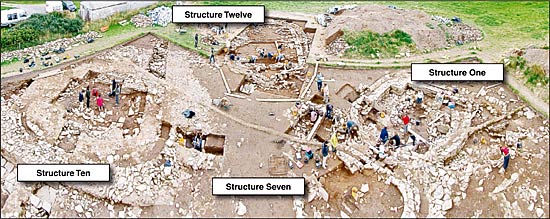
Ongoing archaeological excavations, by Nick Card of the Orkney Research Centre for Archaeology (ORCA), have revealed the remains of a stunning Neolithic site at the Ness of Brodgar, in Orkney. It consists of a least four exceptionally well preserved stone buildings that contain extensive evidence for Neolithic artwork, pottery, bones and stone tools. These closely spaced structures are located roughly mid-way between the World Heritage Sites of the Ring of Brodgar and the Standing Stones of Stenness, both of which are also Neolithic in date.
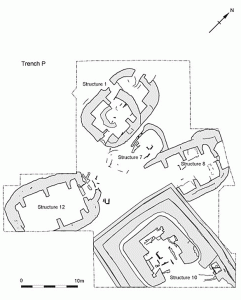
The largest building at the site, ‘Structure 10’, is truly monumental in size, measuring 25 metres (82 feet) long by 20 metres (65 feet) wide. Its walls, which are exceptionally well constructed, are 5 meters thick and survive to 1m in height. Inside, however, despite the size of the building’s exterior, the inner, cross-shaped, chamber is comparatively small, measuring 6 metres across. There is a large stone lined hearth at the centre of the structure that contained deep deposits of ash and charcoal as well as large amounts of animal bone and a cup marked stone. The chamber contains at least three examples of stone dressers, some of which have been embellished with rock art. Similar ‘dressers’ were also identified at the nearby Neolithic village of Skara Brae and these may represent storage cupboards or possibly altar spaces.
Outside Structure 10’s massive external wall was a carefully paved area, lying between it and an outer wall that once enclosed the building. The paved passage has led to speculation that Structure 10 once featured a massive roof, the eaves possibly coming out as far as the outer wall and lending the outer paved area the impression of an access passage, or walkway. The original function of this massive building is still being debated, with various theories including a temple or chieftains house being suggested.
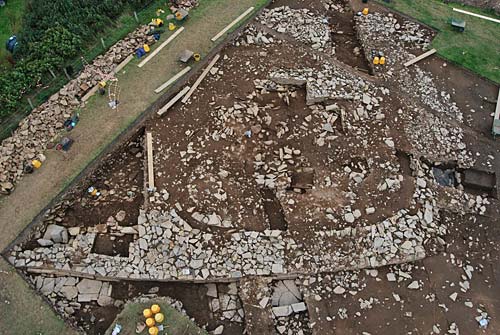
Evidence for how the structures may have been roofed was also identified at the site, in the form of stone slates. Site director, Nick Card, explained that these consisted of ‘flat stone slabs, most of which would appear to be a standard thickness’. These had been ‘carefully shaped, with the edges trimmed to form regular, rectangular slates’. With no evidence of post holes inside the structure, it seems likely that a wooden framework was secured to the top of the building’s walls, and the slates attached to it. Nick added: ‘Mixed in with the slates are also some deposits of clay, was this used to calk the spaces between the slates to stop water ingress? Or possibly to bed the slates down on so as to achieve a more regular profile for the roof?’
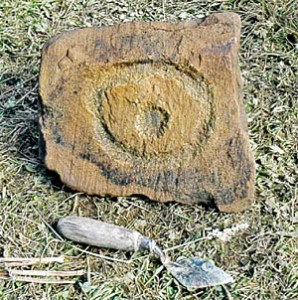
A very unusual feature seen in two of the buildings was the presence of painted stones within them. These were located along the interior walls and appeared to have been randomly placed. The colours used were primarily reddish browns, yellows and oranges, whose pigments were probably derived from material like haematite and limonite — iron ores found in nearby Hoy. In addition, numerous pieces of Neolithic ‘art’ were recovered from within and around the buildings. According to Nick Card ‘We’ve got the full spectrum of Neolithic ‘art’ here. From simple, incised decoration to pecking and more substantial carved motifs. For obvious reasons we can’t say for sure what these represent — whether purely decoration, ritually symbolic or perhaps just somebody making their mark on a structure.’ One of the more spectacular pieces of art is the ‘Brodgar eye’, which was recovered from Structure 10. It has been speculated that this cup and circle marked stone (which does look very like an eye) may have been a representation of the sun.
A wide range of pottery types, stones tools and animal bones were also recovered from the site. Indeed the diversity of pottery found, including a decorated pot sherd featuring a design very similar to those found in Skara Brae, led the excavator to suggest that the Ness site was a focus for a number of communities — perhaps visited by people from all over Stone Age Orkney.
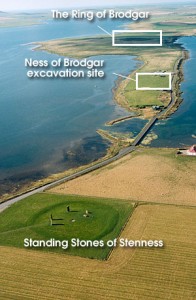
The function of the site remains uncertain, but its location, between the Ring of Brodgar and the Standing Stones of Stenness, could indicate that it had some sort of religious significance. It may even have been the focal point of this ritual landscape, with the large stone structures representing some form of temples. Dr Colin Richards of the University of Manchester has suggested that the site may represent some form of tribal gathering ground, with different groups, probably of related kin, each building discrete and special family buildings at Ness. These structures may have been used as staging points/bases for ritual circuits involving the Ring of Brodgar and the Standing Stones of Stenness. Conversely, the site may also represent some form of high status settlement.
Further excavation work and post excavation analysis will hopefully bring us closer to the truth. However, what is beyond doubt is the significance this spectacular Neolithic site.
Links:
The information for this Blog post was primarily derived from the excellent Orkneyjar website



I wonder if any one has looked below the present day sea level for old structures from before the ice melted and raised the sea level. might be interesting to try to find structures between iceland and the orkneys, under water